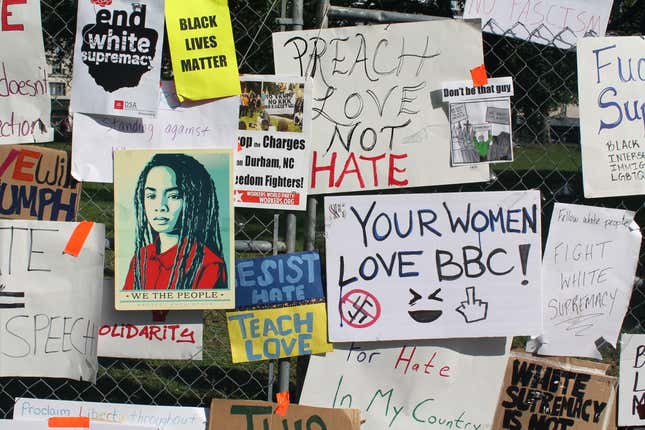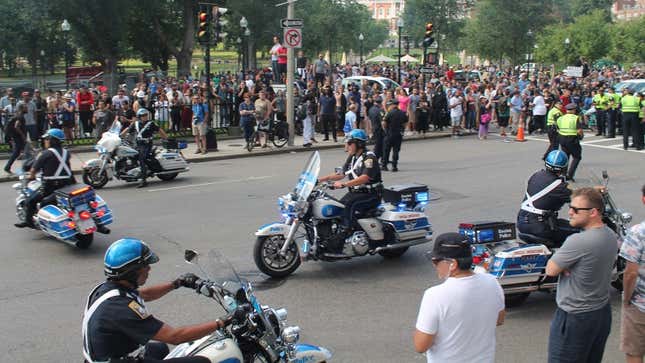
“We didn’t know the KKK was in Boston!” one woman said excitedly, boarding the bus to the Boston Common around noon today for the protests against last weekend’s violence in Charlottesville. She and her friend had heard that white supremacists were in town, and, like diehard Sox fans, word of the opposition was enough to get them on the first bus to the face-off.
But fifteen minutes later, it turned out that, in fact, the KKK is not in Boston–or, if today’s showing was accurate, then they’re outnumbered by two thousand to one. Early in the protest, pockets of thirty or so left-leaning protestors congregated around shouting matches with the very few people who’d had the gall to show up in patriot-themed gear. The spats usually diffused anti-climactically.
A perfect example is this argument between a young black man and two guys in a MAGA hat and American flag bandana, spoken purely in Boston’s native tongue:
White center-right guy: “I’m a center right person.”
Man in straw hat: “Well God Bless America then.”
White center-right guy: “Well then what are you asking me if I’m a Nazi or a Klan member? We’re in Massachusetts, how many fuckin’ Nazis and Klan members do you think live here?...If you did a poll in America of ‘do you like Nazis,’ it would be like 90 somethin’ percent of the country would be like fuck the Nazis. Nobody likes Nazis.”
Man in straw hat: “Then we’re all in agreement!”
[Applause]
Not that many people didn’t hope for Nazis. Antifa was out in full force in gas masks and goggles, and throughout the day, hundreds of protestors tore through the crowd chasing down supposed white supremacists, splashing water and tossing coins at them til the police came to detain the culprits. But the who-started-it’s were always fuzzy. “Some guy over there was talkin’ shit, so they chased him down,” was about an average explanation from a woman. “Boston doesn’t play that shit,” she added.
Another group of four adults standing in front of an American flag (who would come to be known as “the free speech people”) became a magnet–presumably because at the moment patriot-themed paraphernalia translates to free speech, which is code for protecting hate speech. I asked one of the men–an older veteran with a white mustache–why he’d come out.
“I dunno. Some people are offended by the American flag. I don’t get that,” he said, while a woman yelled, “Are you racist? Are you racist?”
“I don’t know what a lot of these groups stand for,” he said, confused. It was unclear what he stood for, either, or why he was here–just that this seemed to be a meaningful occasion for patriots.
“What do you stand for?” a woman shouted from the crowd.
“We’re American! That means we’re a melting pot!” answered one of the other flag men.
“I’m confused. I’m confused about why they’re all yelling,” the veteran told me.
Then he and his wife left.
A highlight occurred when police in riot gear tore through the crowd shouting “We’ve got another one!” with a man in custody, whom some witnesses claimed had a gun. (In the end, ABC reported that 33 arrests were made today).
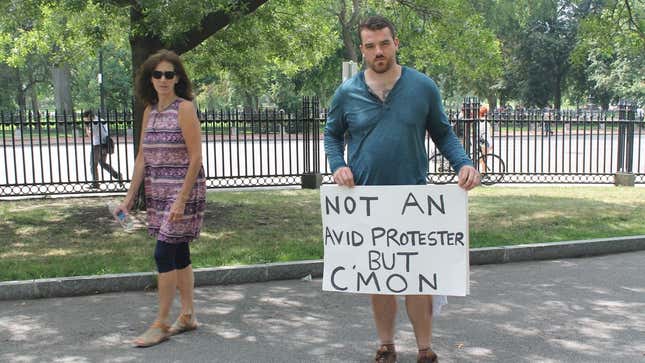
In between were moderates who didn’t even know til recently that Antifa or neo-Nazis existed. One 23-year-old man told me that even though he’s conservative, he thinks what happened last week was terrible and Trump is an idiotic poor excuse of a president. I asked him if that’s why he wasn’t wearing a “Make America Great Again” hat.
“As a conservative I think it’s stupid because you’re going to argue with people,” he said. “But at the same time, it’s a beacon saying hey, over here, talk to me. I have different views than you do.”
But throughout the afternoon, tens of thousands of marchers seemed on-message with “Black Lives Matter” and “Resist Hate” signs. Brittany Botto, a mixed-race woman in her twenties, said that even though she’d been called the n-word four times on her way to the protest by a small group of white men, she felt overwhelming positivity. “I feel like the only people who make it on the news are Nazis and people who spread negativity,” she said.
It occurred to me that I’ve never seen so many people of color on the Boston Common, the big park in the center of the city, flanked by the “old money”-type Beacon Hill neighborhood, the State House, and several high-end restaurants and bookstores. The Common and the nearby Public Garden boast statues of abolitionists and Revolutionary War heroes, indicating that the city was on the right side of history. But when I grew up here in the nineties–and granted it’s been nearly a decade since I moved from home–Boston’s brand of racism was an unspoken separate-but-equal policy. Blacks and whites didn’t live in the same neighborhoods or go to the same schools; “diversity” was white person code for “black people in white places.” If there is a protest slogan which captures the Boston I’ve experienced, it would be “White silence=violence.”
Under the din of helicopters and amidst a few cops mulling around, a few middle aged lifelong Boston residents remembered growing up in that divided town: the town which was last to admit blacks to its baseball team, where the busing desegregation riots of the late seventies were a recent memory. Rich Gideon and Roosevelt Robinson recalled the Charles Stuart murder [in which a white man wrongfully accused a black man of shooting his pregnant wife] when they couldn’t go out at night without getting searched. They remember being unwelcome in South Boston and neighborhoods on the outskirts. Boston looks different today, but one didn’t need to look further than nearby Jodi Finnegan’s sign “All lives matter but not every race is targeted for execution” for a quick reminder of how the racism has morphed into what she calls “the new lynching.”
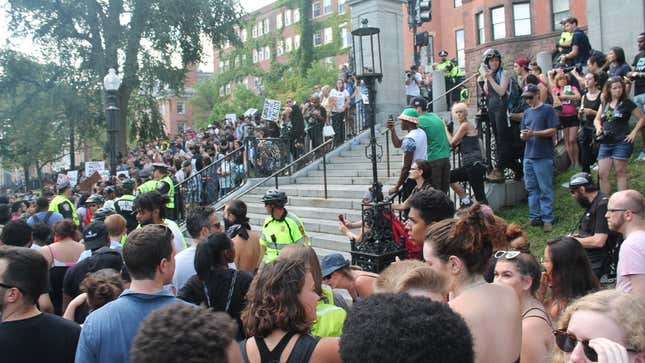
Lacking Nazis, the energy gravitated more toward the lingering fury around police killings. By 3 PM, a crowd of hundreds chanting “Not my President!” had gathered around a group of police on a flight of stairs, jeering any taunts that came to mind, like, “You like that water?” at a policeman drinking water.
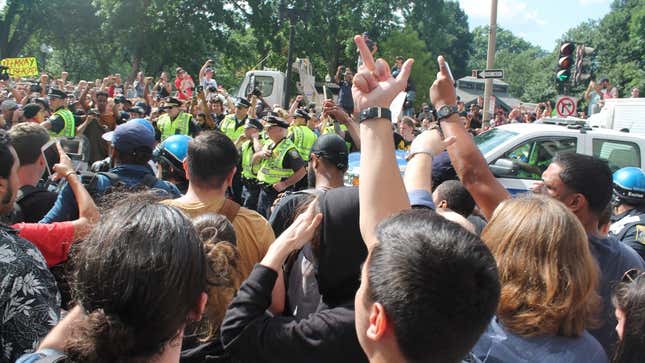
Early in the afternoon, a cheery bike cop remarked that for the most part people were “on good behavior” (and he was really cheery, given that cops never talk to journalists). But by 3:45, the tone had reversed; a crowd on Tremont had surrounded a group of police, throwing rocks and water (Police Commissioner Evans has reported that there was urine), and I saw an officer violently throw a young girl in a headlock and push her to the ground while a motorcycle cop forcibly drove people aside. But again, surprisingly, the police eventually walked away. Out came a bongo drum. The Nazis were gone, whether they were there or not, and one person cheered: “We won!”
I’m not sure whether throwing stuff at police in general is productive, but this is not the city I grew up in, and that doesn’t seem to be missed.
